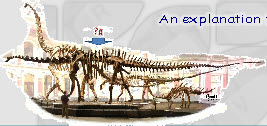


Q. Does Hokkanen’s paper, The Size of the Largest Land Animal, prove that dinosaurs could grow to their gigantic size in our present gravity?
A. This old paper (1985) by Hokkanen attempts to calculate the largest land animal that could exist. [1] It is sometimes quoted as proof that gravity has remained constant. A typical use of Hokkanen’s paper to assume no variation in ancient gravity is given in Biology of the sauropod dinosaurs: the evolution of gigantism, were the authors state "... Hokkanen (1986) calculated that bone strength and muscle forces only become limiting to terrestrial animal size at masses in excess of 100 t.” [2] Some science writers use these quotes to claim, "paleontologist [have] debunked the proposal that Jurassic gravity was weaker." In practice, a more rigorous examination of Hokkanen’s paper indicates that it does not prove gravity is unchanged and should not be to offered as firm proof that the Earth’s ancient gravity was the same as now.
Hokkanen used some elementary physics to calculate the maximum stress that a leg bone could withstand and then assumes that this represents the upper mass of any animal. He concluded that the upper limit for bone strength “seems to be between 105 and 106 kg, at least” (10 to 100 tonne). But Hokkanen’s 1985 paper also noted that a “heavier animal, being closer to a break-down because of its relatively weaker muscles and fragile bone structure, behaves accordingly and avoids jumps and other sudden accelerations”, from which he concludes that the athletic ability of the largest animal would be so low that, “a mass 106 kg allows a running speed of 6 km/h – a man could walk and overtake”. By “running speed” he was calculating the maximum possible speed that this large animal could move. This could never be described as a run as it is normally understood. Perhaps the closest we might encounter is a very aged individual who has extreme difficulty in walking – never mind running. The speed is so slow that it would not even seem to be walking as we understand it – perhaps a slow shuffle would be a better description. Small animals could easily overtake this large animal making it prone to attacks since it would be unable to defend itself. I can’t think of any modern paleontologists who would argue that the sauropods were this unathletic so I would advise that it would be unwise to present this paper as providing conclusive arguments that the largest of the dinosaurs could exist in our present gravity.
A. This old paper (1985) by Hokkanen attempts to calculate the largest land animal that could exist. [1] It is sometimes quoted as proof that gravity has remained constant. A typical use of Hokkanen’s paper to assume no variation in ancient gravity is given in Biology of the sauropod dinosaurs: the evolution of gigantism, were the authors state "... Hokkanen (1986) calculated that bone strength and muscle forces only become limiting to terrestrial animal size at masses in excess of 100 t.” [2] Some science writers use these quotes to claim, "paleontologist [have] debunked the proposal that Jurassic gravity was weaker." In practice, a more rigorous examination of Hokkanen’s paper indicates that it does not prove gravity is unchanged and should not be to offered as firm proof that the Earth’s ancient gravity was the same as now.
Hokkanen used some elementary physics to calculate the maximum stress that a leg bone could withstand and then assumes that this represents the upper mass of any animal. He concluded that the upper limit for bone strength “seems to be between 105 and 106 kg, at least” (10 to 100 tonne). But Hokkanen’s 1985 paper also noted that a “heavier animal, being closer to a break-down because of its relatively weaker muscles and fragile bone structure, behaves accordingly and avoids jumps and other sudden accelerations”, from which he concludes that the athletic ability of the largest animal would be so low that, “a mass 106 kg allows a running speed of 6 km/h – a man could walk and overtake”. By “running speed” he was calculating the maximum possible speed that this large animal could move. This could never be described as a run as it is normally understood. Perhaps the closest we might encounter is a very aged individual who has extreme difficulty in walking – never mind running. The speed is so slow that it would not even seem to be walking as we understand it – perhaps a slow shuffle would be a better description. Small animals could easily overtake this large animal making it prone to attacks since it would be unable to defend itself. I can’t think of any modern paleontologists who would argue that the sauropods were this unathletic so I would advise that it would be unwise to present this paper as providing conclusive arguments that the largest of the dinosaurs could exist in our present gravity.
|
1.
|
|
2.
|
Updated 17Apr13




